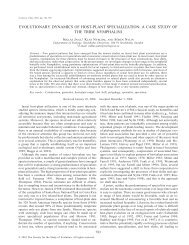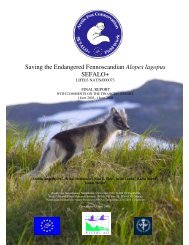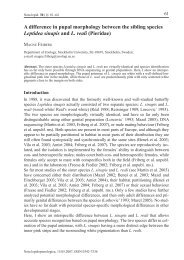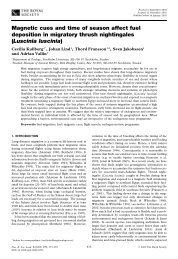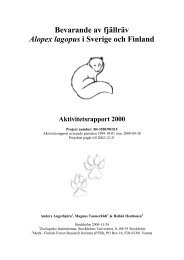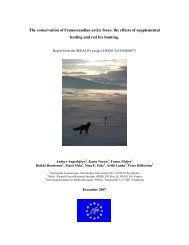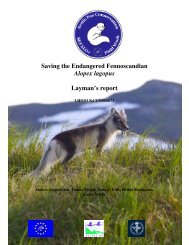Food-niche overlap between arctic and red foxes
Food-niche overlap between arctic and red foxes
Food-niche overlap between arctic and red foxes
You also want an ePaper? Increase the reach of your titles
YUMPU automatically turns print PDFs into web optimized ePapers that Google loves.
1280 Can. J. Zool. Vol. 80, 2002Fig. 1. The diets of <strong>arctic</strong> <strong>foxes</strong> (Alopex lagopus) (a) <strong>and</strong> <strong>red</strong> <strong>foxes</strong> (Vulpes vulpes) (b) in different summers. Unidentified remains ofsmall mammals (see Table 1) are distributed among categories of identified small-mammal species according to the distribution ofthose species in the scats.often in <strong>arctic</strong> fox scats than in <strong>red</strong> fox scats in 1993, whilethe reverse was true in other years (Tables 1 <strong>and</strong> 3). Passerines,ptarmigans, <strong>and</strong> ducks were all utilized by both foxspecies. Passerines were consumed most often, while duckswere eaten on only a few occasions. On average, <strong>red</strong> <strong>and</strong><strong>arctic</strong> <strong>foxes</strong> ate passerines equally often. However, <strong>red</strong> <strong>foxes</strong>ate passerines more often than <strong>arctic</strong> <strong>foxes</strong> did in 2 years,while the reverse was true in the other 2 years. Therefore,the three-way interaction <strong>between</strong> year, species, <strong>and</strong> passerineswas significant, although there were no significant twowayinteractions. There were no effects of fox species oryear on the occurrence of ptarmigan <strong>and</strong> ducks in the scats(Tables 1 <strong>and</strong> 3).There were no effects of fox species or year on the occurrenceof eggshells, insects, or vegetation in the scats (p >0.28). Eggshells <strong>and</strong> insects occur<strong>red</strong> infrequently <strong>and</strong> innegligible volumes. Vegetation occur<strong>red</strong> frequently in thescats, but only in trace amounts (Table 1).To summarize, there were three important differences <strong>between</strong><strong>arctic</strong> <strong>and</strong> <strong>red</strong> fox diets: lemmings occur<strong>red</strong> more oftenin the diet of <strong>arctic</strong> <strong>foxes</strong>, while field voles <strong>and</strong> birdsoccur<strong>red</strong> more often in the diet of <strong>red</strong> <strong>foxes</strong>. However, thesummer diets of both species varied over time <strong>and</strong> the frequenciesof occurrence of lemmings, field voles, reindeer,<strong>and</strong> birds in the diets varied significantly among years.<strong>Food</strong>-<strong>niche</strong> breadth <strong>and</strong> food-<strong>niche</strong> <strong>overlap</strong>The diets of both fox species varied considerably amongyears <strong>and</strong> this was reflected by large variations in food-<strong>niche</strong><strong>overlap</strong> within species among years. The average percent© 2002 NRC Canada



